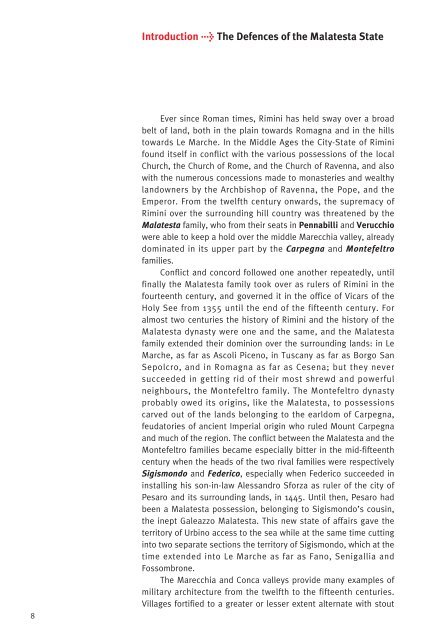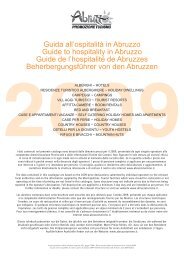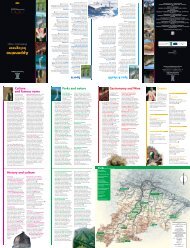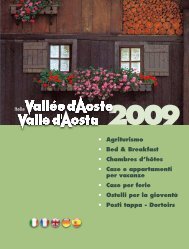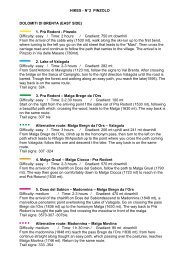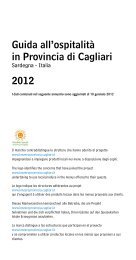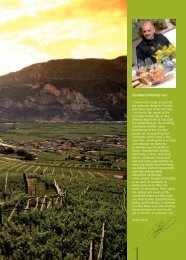Malatesta fortresses and castles
Malatesta fortresses and castles
Malatesta fortresses and castles
Create successful ePaper yourself
Turn your PDF publications into a flip-book with our unique Google optimized e-Paper software.
Introduction > The Defences of the <strong>Malatesta</strong> State<br />
8<br />
Ever since Roman times, Rimini has held sway over a broad<br />
belt of l<strong>and</strong>, both in the plain towards Romagna <strong>and</strong> in the hills<br />
towards Le Marche. In the Middle Ages the City-State of Rimini<br />
found itself in conflict with the various possessions of the local<br />
Church, the Church of Rome, <strong>and</strong> the Church of Ravenna, <strong>and</strong> also<br />
with the numerous concessions made to monasteries <strong>and</strong> wealthy<br />
l<strong>and</strong>owners by the Archbishop of Ravenna, the Pope, <strong>and</strong> the<br />
Emperor. From the twelfth century onwards, the supremacy of<br />
Rimini over the surrounding hill country was threatened by the<br />
<strong>Malatesta</strong> family, who from their seats in Pennabilli <strong>and</strong> Verucchio<br />
were able to keep a hold over the middle Marecchia valley, already<br />
dominated in its upper part by the Carpegna <strong>and</strong> Montefeltro<br />
families.<br />
Conflict <strong>and</strong> concord followed one another repeatedly, until<br />
finally the <strong>Malatesta</strong> family took over as rulers of Rimini in the<br />
fourteenth century, <strong>and</strong> governed it in the office of Vicars of the<br />
Holy See from 1355 until the end of the fifteenth century. For<br />
almost two centuries the history of Rimini <strong>and</strong> the history of the<br />
<strong>Malatesta</strong> dynasty were one <strong>and</strong> the same, <strong>and</strong> the <strong>Malatesta</strong><br />
family extended their dominion over the surrounding l<strong>and</strong>s: in Le<br />
Marche, as far as Ascoli Piceno, in Tuscany as far as Borgo San<br />
Sepolcro, <strong>and</strong> in Romagna as far as Cesena; but they never<br />
succeeded in getting rid of their most shrewd <strong>and</strong> powerful<br />
neighbours, the Montefeltro family. The Montefeltro dynasty<br />
probably owed its origins, like the <strong>Malatesta</strong>, to possessions<br />
carved out of the l<strong>and</strong>s belonging to the earldom of Carpegna,<br />
feudatories of ancient Imperial origin who ruled Mount Carpegna<br />
<strong>and</strong> much of the region. The conflict between the <strong>Malatesta</strong> <strong>and</strong> the<br />
Montefeltro families became especially bitter in the mid-fifteenth<br />
century when the heads of the two rival families were respectively<br />
Sigismondo <strong>and</strong> Federico, especially when Federico succeeded in<br />
installing his son-in-law Aless<strong>and</strong>ro Sforza as ruler of the city of<br />
Pesaro <strong>and</strong> its surrounding l<strong>and</strong>s, in 1445. Until then, Pesaro had<br />
been a <strong>Malatesta</strong> possession, belonging to Sigismondo’s cousin,<br />
the inept Galeazzo <strong>Malatesta</strong>. This new state of affairs gave the<br />
territory of Urbino access to the sea while at the same time cutting<br />
into two separate sections the territory of Sigismondo, which at the<br />
time extended into Le Marche as far as Fano, Senigallia <strong>and</strong><br />
Fossombrone.<br />
The Marecchia <strong>and</strong> Conca valleys provide many examples of<br />
military architecture from the twelfth to the fifteenth centuries.<br />
Villages fortified to a greater or lesser extent alternate with stout


